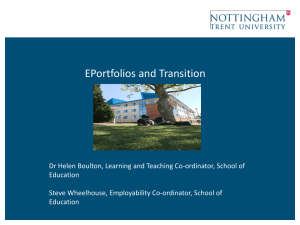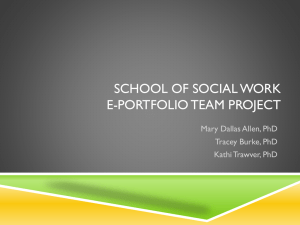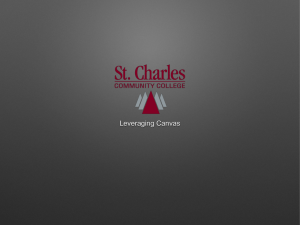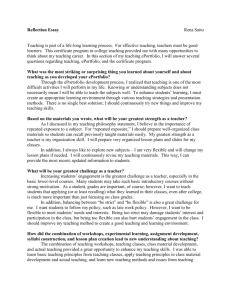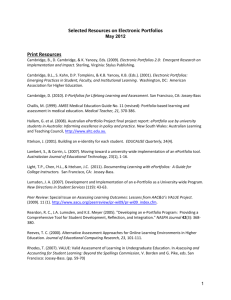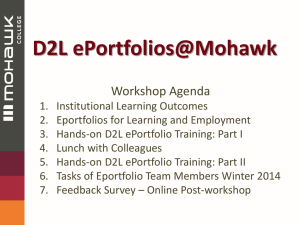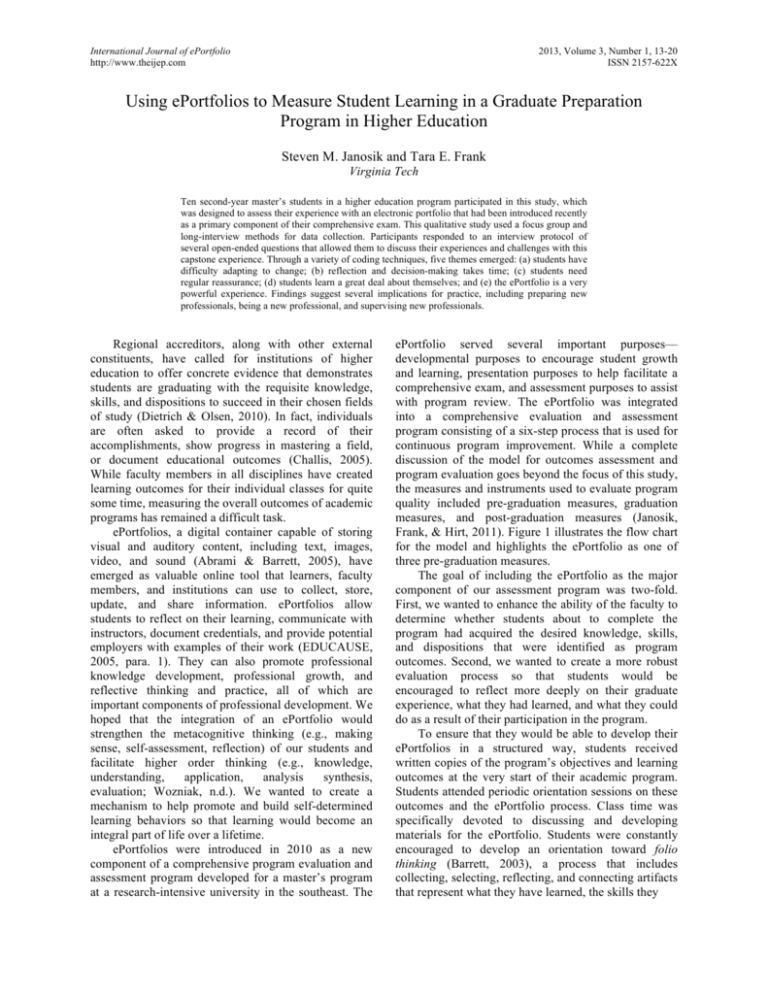
International Journal of ePortfolio
http://www.theijep.com
2013, Volume 3, Number 1, 13-20
ISSN 2157-622X
Using ePortfolios to Measure Student Learning in a Graduate Preparation
Program in Higher Education
Steven M. Janosik and Tara E. Frank
Virginia Tech
Ten second-year master’s students in a higher education program participated in this study, which
was designed to assess their experience with an electronic portfolio that had been introduced recently
as a primary component of their comprehensive exam. This qualitative study used a focus group and
long-interview methods for data collection. Participants responded to an interview protocol of
several open-ended questions that allowed them to discuss their experiences and challenges with this
capstone experience. Through a variety of coding techniques, five themes emerged: (a) students have
difficulty adapting to change; (b) reflection and decision-making takes time; (c) students need
regular reassurance; (d) students learn a great deal about themselves; and (e) the ePortfolio is a very
powerful experience. Findings suggest several implications for practice, including preparing new
professionals, being a new professional, and supervising new professionals.
Regional accreditors, along with other external
constituents, have called for institutions of higher
education to offer concrete evidence that demonstrates
students are graduating with the requisite knowledge,
skills, and dispositions to succeed in their chosen fields
of study (Dietrich & Olsen, 2010). In fact, individuals
are often asked to provide a record of their
accomplishments, show progress in mastering a field,
or document educational outcomes (Challis, 2005).
While faculty members in all disciplines have created
learning outcomes for their individual classes for quite
some time, measuring the overall outcomes of academic
programs has remained a difficult task.
ePortfolios, a digital container capable of storing
visual and auditory content, including text, images,
video, and sound (Abrami & Barrett, 2005), have
emerged as valuable online tool that learners, faculty
members, and institutions can use to collect, store,
update, and share information. ePortfolios allow
students to reflect on their learning, communicate with
instructors, document credentials, and provide potential
employers with examples of their work (EDUCAUSE,
2005, para. 1). They can also promote professional
knowledge development, professional growth, and
reflective thinking and practice, all of which are
important components of professional development. We
hoped that the integration of an ePortfolio would
strengthen the metacognitive thinking (e.g., making
sense, self-assessment, reflection) of our students and
facilitate higher order thinking (e.g., knowledge,
understanding,
application,
analysis
synthesis,
evaluation; Wozniak, n.d.). We wanted to create a
mechanism to help promote and build self-determined
learning behaviors so that learning would become an
integral part of life over a lifetime.
ePortfolios were introduced in 2010 as a new
component of a comprehensive program evaluation and
assessment program developed for a master’s program
at a research-intensive university in the southeast. The
ePortfolio served several important purposes—
developmental purposes to encourage student growth
and learning, presentation purposes to help facilitate a
comprehensive exam, and assessment purposes to assist
with program review. The ePortfolio was integrated
into a comprehensive evaluation and assessment
program consisting of a six-step process that is used for
continuous program improvement. While a complete
discussion of the model for outcomes assessment and
program evaluation goes beyond the focus of this study,
the measures and instruments used to evaluate program
quality included pre-graduation measures, graduation
measures, and post-graduation measures (Janosik,
Frank, & Hirt, 2011). Figure 1 illustrates the flow chart
for the model and highlights the ePortfolio as one of
three pre-graduation measures.
The goal of including the ePortfolio as the major
component of our assessment program was two-fold.
First, we wanted to enhance the ability of the faculty to
determine whether students about to complete the
program had acquired the desired knowledge, skills,
and dispositions that were identified as program
outcomes. Second, we wanted to create a more robust
evaluation process so that students would be
encouraged to reflect more deeply on their graduate
experience, what they had learned, and what they could
do as a result of their participation in the program.
To ensure that they would be able to develop their
ePortfolios in a structured way, students received
written copies of the program’s objectives and learning
outcomes at the very start of their academic program.
Students attended periodic orientation sessions on these
outcomes and the ePortfolio process. Class time was
specifically devoted to discussing and developing
materials for the ePortfolio. Students were constantly
encouraged to develop an orientation toward folio
thinking (Barrett, 2003), a process that includes
collecting, selecting, reflecting, and connecting artifacts
that represent what they have learned, the skills they
Janosik and Frank
Using ePortfolios to Measure Student Learning
14
Figure 1
A Model for Outcomes Assessment and Program Evaluation for
Graduate Preparation Programs in Higher Education
1. Underlying Values &
CAS Standards
2. Program
Characteristics
6. Program
Evaluation
Progress Toward Degree Form
Current Student Assessment
3. Curriculum
ePortfolio & Comp. Exam
On-time Graduation Rate
In-Field Employment Rate
4. Learning Outcomes
5. Instruments and
Measures
Pre-Graduation Data
Graduation Data
Stakeholder Assessment
Alumni Assessment
Post-Graduation Data
Employer Assessment
Copyright © 2011. All rights reserved.
Janosik and Frank
Using ePortfolios to Measure Student Learning
have acquired, or the dispositions they have developed
while in the program. On the faculty side, professors
integrated the learning outcomes into their course
syllabi and course assignments. They also gave students
constant feedback on how assignments and experiences
might be used to illustrate the knowledge, skills, or
dispositions learned while in the program. After the
first year of implementation, faculty members involved
in the comprehensive exams were very pleased and
overwhelmingly positive about the results. They
reported informally that students had no difficulty in
translating course assignments, graduate assistant
placements, and field studies into examples of
knowledge learned, skills acquired, and professional
dispositions developed.
The purpose of this research, then, was to address
the second goal and determine whether the ePortfolio
added value to the overall program evaluation and
assessment plan from the students’ perspective. The
following research question guided this study: How did
participants describe their experience with a newly
created ePortfolio process as the major component of
their comprehensive exam?
Method
A qualitative approach was used in data collection
and analysis to explore the efficacy of newly introduced
ePortfolio, which had been designed to measure
knowledge, skills, and dispositions for graduating
master’s students in a higher education program. Openended questioning and grounded theory analysis were
appropriate choices, since our goal was to explore the
variety of experiences among a similar group of
participants (Creswell, 1998). Such an approach
enabled us to present the essence (Merriam, 2002) of
the phenomena through the eyes of the participants. We
wanted to include contextual information as well as
stories of the participants from their individual points of
view (Marshall & Rossman, 2006).
Participants
After obtaining Institutional Review Board
approval for data collection, we selected participants
using a purposeful sampling method (Patton, 2002).
Twelve students participating in the ePortfolio process
for the program were sent an email message inviting
them to participate in a focus group exploring their
experience. While all 12 students initially agreed to
participate in the research process, only 10 were able to
complete the interview process.
All of the participants were enrolled in nine hours
of coursework and held full-time (20 hours per week)
assistantships at the time the study was conducted.
Their program consisted of 48 credit hours of course
15
work, which included a minimum of two field
experiences, and was located at a large public researchintensive university in the southeast. All 10 students
had applied for graduation and were in good academic
standing. Interviews were conducted after their exams
and all course work had been completed. Six of the
respondents were women and four were men. When we
examined race, we found that six respondents were
Caucasian, two respondents were African American,
one respondent was Asian American, and one
respondent was biracial.
Data Collection
Data on our participants’ experience with ePortfolios
were collected via a focus group and one long interview. A
focus group consists of individuals with similar
backgrounds participating in an interview process that
encourages discussion and allows individuals to share their
personal experiences in the social context of others (Patton,
2002). This focus group was used to capture the individual
and group experiences of those participating in the
ePortfolio process and distinguish patterns of response
within the group. The facilitator of the focus group made
frequent use of prompts to ensure that everyone
participated and that everyone had a chance to speak before
moving on to another question. The facilitator occasionally
asked for clarification and would express appreciation for a
focus group member’s participation as a way to encourage
more discussion but did not contribute any new information
to the conversation. The focus group consisted of nine
students who had completed the ePortfolio requirement at
the time of their interview. Not all participants were able to
participate in the focus group, however. One researcher
conducted the focus group and a standardized, open-ended
interview with one participant who was unable to attend the
focus group. Although she knew the participants well, she
was not responsible for grading any coursework or
determining the outcome of the comprehensive exam. The
participant not able to attend the group session completed
an individual interview and responded to the same set of
questions asked in the focus group.
To attend to the purpose of the research project, we
developed several prompts to elicit information.
Examples of these prompts included:
•
•
•
•
•
How might the instructions and orientation
about the ePortfolio process be improved?
What was the easiest part of the ePortfolio
process?
What was the most difficult part of the
process?
What did you learn about yourself as a result
of this process?
How have you used the ePortfolio beyond the
requirements for the exam?
Janosik and Frank
Using ePortfolios to Measure Student Learning
While the interview captured only an individual’s
experience, common themes were found between the
focus group and the individual interview.
Data Analysis
The focus group and individual interviews were
recorded and transcribed. Pseudonyms were given to
each student to protect the individual’s identity. Content
analysis was conducted by each of the researchers in an
attempt to make sense of the qualitative data obtained
through the focus group and individual interview. First,
open coding was used. Then, axial and selective coding
was used to develop emergent themes from the data
(Patton, 2002; Strauss & Corbin, 1998). Finally, we
used a constant comparative strategy to integrate these
emerging themes into core themes.
To help establish trustworthiness by ensuring the
accuracy of the data (Creswell, 1998), participants’
responses were transcribed verbatim. As a measure of
analytic trustworthiness, we worked independently to
analyze the data and identify emergent themes. Then
we compared emerging themes for congruence and
dissonance (Renn & Hodges, 2007) and agreed on a set
of five core themes.
Limitations
The major limitations of the study stem from the
nature of the sample. Participants were drawn from one
master’s program. Clearly, the findings gleaned from
this sample cannot represent the experiences of all
master’s level student affairs professionals with an
ePortfolio process designed to measure the knowledge,
skills, and dispositions gained in their graduate
program. Additional limitations lie in data collection.
Some researchers question the credibility of selfreported data (Furnham & Henderson, 1982; Howard,
1994). While there is always the chance that
respondents might say things to represent themselves in
a favorable light, we had no reason to believe that our
participants did so. In addition, we did not perform
member checks, nor was there a direct follow-up with
participants to clarify or deepen their responses. Still,
we believe that the findings can contribute to a deeper
understanding of the utility of using an ePortfolio as the
cornerstone of a comprehensive exam in a graduate
preparation program.
Findings
Five core themes emerged from the data related to
the research questions: (a) students have difficulty
adapting to change, (b) reflection and decision-making
take time, (c) students need regular reassurance, (d)
students learn a great deal about themselves, and (e) the
16
ePortfolio is a very powerful experience. After
analyzing the transcripts, each researcher generated,
independently, a list of potential themes. The themes
outlined in this paper are a result of consultation and
agreement between the two researchers.
Students Have Difficulty Adapting to Change
The ePortfolio was introduced in early October,
after the start of the cohort’s first year in the program.
As the first cohort completing an ePortfolio, students
were reluctant to accept the change in curriculum.
Initially students were unclear about the value of the
exercise. One student stated,
I know when I was originally thinking about it, I
was just thinking of it as kind of a glorified power
point [sic] . . . and then I got into it and realized
[there] was much more reflection [involved] than I
thought.
Delia (all student names are pseudonyms) also stated
that “the big picture, like what we were supposed to be
actually doing, was difficult to understand.” Other
students indicated a preference for the options to
complete theses or independent studies, which had been
used as part of the comprehensive exams in past years.
Interestingly, Wickersham and Chambers (2006) also
found this resistance to change and preference for other
activities in their study of graduate students in a
secondary education program but their assessment came
after only one semester of implementation.
Students also had difficulty adapting to the
platform (i.e., Sakai) used for creating the ePortfolios
(Sakai is called “Scholar” at the institution where the
study took place). The interface was slow. Although it
operated in a fashion much like Microsoft Word and
used common HyperText Markup Language (HTML)
commands, Sakai was reported as being less than userfriendly. Several students asked and were given
permission to use other platforms. David stated that:
If the [faculty] requires students to use Sakai, I
don’t know how [we] will do it . . . I feel like I
need training in HTML, which is so beyond our
scope . . . how would we, as education students, . . .
know how to do that?
Ellen also expressed some concern by stating, “I feel
like [in] Sakai [when] you make one little mistake . . . it
erased the entire page I had been working on for days.”
Other students expressed similar frustrations. John
offered a solution by suggesting,
I wouldn’t want to, as a future incoming student, be
limited . . . to Sakai or . . . Google. I think [the
Janosik and Frank
platform choice] could be open to whatever
because there’s [sic] more opportunities or
different venues to create an ePortfolio. I think
assigning one or mandating one or requiring one
would . . . limit the possibilities of where the
ePortfolio could go in the future.
Students agreed generally that expanding the
platforms available could encourage creativity and
allow students to create an ePortfolio that used their
strengths.
Reflection and Decision-Making Take Time
Throughout the students’ two-year program,
faculty members would remind students of the learning
objectives for the program and how they could be
incorporated into their ePortfolios. To help with the
development of the final product, students were
encouraged to upload files and make notes on a
frequent basis. They were also required to enroll in a
three-credit independent study as a way to focus their
attention on this task. Overall, students felt that figuring
out how the ePortfolio could best reflect their work and
growth during their tenure in graduate school took time
and significant effort. Deciding what content best
described their graduate school experiences was
difficult. Ann stated:
I think the hardest thing for me was trying to
decide what you were going to put in the ePortfolio
because there’s a lot of information you cover
within two years; your cognates, academic
curriculum, practicum experiences . . . deciding
what’s more important than others . . . was a
challenge.
Putting the ePortfolio together took much more
time than students anticipated. Many participants stated
they underestimated the amount of time it would take to
put together an effective ePortfolio. Jenny stated, after
being asked what surprised her most about the
ePortfolio process, responded:
The time it took. . . I know we had all semester for
this independent study but I really thought I could
put this together in a couple of weeks. I found out
quickly that was not the case. I was spending eight
hours a day trying to put it together. I think it took
a very long time to incorporate all of the
information.
Using ePortfolios to Measure Student Learning
17
program was devoted to creating the ePortfolio, another
general information session was held, and two meetings
were scheduled with staff members in Learning
Technologies who were responsible for supporting the
ePortfolio project at the institution. These staff
members, under the guidance of the program faculty
members, also developed a standard template for
student use and a user’s manual specifically for the
students in the program. Despite these resources,
students needed to check-in with faculty members
while working on their ePortfolios. They needed regular
reassurance that they were developing their ePortfolios
in ways that met expectations. Several students
remarked they met with faculty members individually
or in small groups on a regular basis to make sure they
were on the right track in creating their ePortfolio. Tom
reported that
a few of us sat down [with the faculty] . . . and said
we don’t know what the physical end product will
look like and, I realized that might be dichotomous
thinking, but that was a lot of pressure since this
was basically what we were going to use to decide
whether we passed or not.
Michael further noted that “[t]he hardest part of this
entire thing, I think, was the ambiguity in it.”
Even though there were some meetings with
faculty members to determine format and expectations,
students reported wanting these meetings to occur more
frequently throughout the semester, as well as earlier in
their graduate career. Stacy stated:
. . . I think, at the same time, it would have been
nice if it started from your first semester to say you
need to start thinking about these things, you need
to start cataloguing your experiences, you can track
them, and then be intentional about getting
experiences you don’t have. I think that would
have been nice to hear that first semester.
Brian stated further that “what might help the structure
[the ePortfolio process] is having more frequent
meetings, like once a month, and saying we expect you
to have one of these tabs by now.” In this case, the
expectation of tabs refers to what content should be
finished by a certain date. Students consistently stated
that they needed more guidance regarding content
expectations and tied that guidance to frequent
meetings with faculty members.
Students Learn a Great Deal about Themselves
Students Need Regular Reassurance
During the course of the first year, one class
meeting in the introductory course for the Master’s
Students acknowledged that the ePortfolio process
pushed them to grow and recognize how much they had
accomplished during their graduate careers. Many
Janosik and Frank
indicated that they had more content for the ePortfolio
than they knew what to do with, and that surprised
them. Students indicated that the experience that the
ePortfolio provided and that evaluating that experience
using the ePortfolio made it easier for them to talk
about their growth as student affairs professionals,
particularly in job interviews. John said, “I did find
myself really reflecting in my [ePortfolio] . . . it was
really helpful to me to articulate some of those things in
job interviews.”
Students also remarked that the ePortfolio process
helped them to see the bigger picture and to understand
holistically how they had learned through their graduate
career. One student stated, “What I have learned in
terms of my own growth was looking at big picture
things and not always expecting things to be laid out for
me.” Jenny reported that the ePortfolio let her see “how
much you have accomplished and if you had your goals
written down initially . . . you can say ‘I really did
accomplish that or I didn’t really expect to do this but I
did and I am grateful now.’” Another student stated that
the ePortfolio process taught her that, as a professional
going into the field, she will have to craft her own
experience: “for me, that’s what I learned. It’s a skill
set. I am going to have to take responsibility for my
own education and make my own experience.”
The ePortfolio Process as a Powerful Experience
Despite technological glitches and initial
uncertainty with the experience, students reported that
the ePortfolio experience was powerful and meaningful,
particularly with the job search process. Students
reported going through the ePortfolio process made
them feel much more competent; one student remarked
that “it made me a lot more confident that I can be a
meaningful contributor to the field.” Several students,
saying the ePortfolio was a real “confidence booster,”
mentioned “increased confidence” as another outcome
of the process. This confidence led students to feeling
strong in their interview experiences because they were
able to articulate what they had learned and what they
could do, as evidenced by their ePortfolio. Michelle
reported:
It helped me articulate my experience better in my
interviews because you really have that time to
reflect on it and connect it and frame it under those
[categories
of]
professional
preparation,
professional involvement, etc. . . .You outline your
values, where you plan to go in the future, etc., and
all of those came up in interviews so it really
helped me.
Brian, when asked how the ePortfolio process added
value to his educational experience, responded:
Using ePortfolios to Measure Student Learning
18
The ePortfolio allowed us to reflect on all of our
experiences and we get to talk about what it is we
have learned, how we’ve grown, and that’s just a
great experience. I think, at this point, as we are
becoming a master, so to speak, in our field, that’s
a good opportunity to have.
Discussion
Participants were unanimous in suggesting that the
ePortfolio created an opportunity to reflect deeply on
their graduate school experiences. The template used as
a guide in this study served to focus student attention on
the learning outcomes of the master’s program and gave
them a mechanism by which they could easily translate
their experiences into evidence in the domains of
knowledge, skills, and dispositions. Despite this
structure, students still needed reassurance and support
as they navigated this process. This is a common theme
found in other ePortfolio assessments (Mason, Pegler,
& Weller, 2004). In addition, requiring students to
present their ePortfolio as a major component of their
comprehensive exam provided participants with an
opportunity to reflect on their learning and performance
as a means for further development, to construct their
personal expertise, and to explore their professional
identity (Rickards et al., 2008). Given the findings of
this study, those contemplating the use of an ePortfolio
process as part of an assessment plan would be wise to
consider the following implications for practice:
1.
2.
Before considering the adoption of an
ePortfolio process, develop a comprehensive
assessment plan (Dietrich & Olsen, 2010). The
mission or objectives of the program should
drive the curriculum and the learning
outcomes. Desired outcomes must be clearly
articulated and reinforced by classroom faculty
members as well as those who advise students
and supervise field experiences. Learning
outcomes and examples of evidence must be
identified. Students in this study wanted clear
direction on what their portfolios should
include and what they should look like at the
end.
Consider carefully the platform that will be
used for the ePortfolio. While several
universities have developed their own
templates, free or commercially available
platforms are also available (e.g., Google,
Carbonmade, Wix, Krop, Design Taxi). This is
an important consideration. Depending upon
the complexity of the template developed and
the technological sophistication of the students
using the platform, computer and server
capacity and speed become important factors.
Janosik and Frank
3.
4.
5.
Using ePortfolios to Measure Student Learning
Video and audio files, pictures, and complex
presentations will require large amounts of
both. More than one platform may be required
to respond adequately to student needs
(Gavaldón, García, & Campos, n.d.).
Construct an ePortfolio template and
supporting documentation for students and
faculty members based on the desired
outcomes of the program. Providing this type
of structure will reduce the ambiguity of the
assignment and lessen the anxiety students
(and faculty members) experience with any
new procedure or process. Develop good
exemplars of what students should expect to
produce (Ring & Ramirez, 2012). Detailed
guidance will also increase the likelihood that
the final product will meet expectations.
Identify the technical support and training
needs of the faculty and students. Although
today’s college students may possess a high
level of skill with all types of technology,
there may be a wide range of ability in any
particular cohort. Program faculty members
may not always be early adopters of
technology and some may need much more
help than others. Integrating an ePortfolio
experience into the curriculum must be user
friendly for all who use it. Resources must be
devoted to continual training and nurturing of
those involved in this assessment process.
As a result of their study, Ring and Ramirez
(2012) suggest that “just-in-time” training
opportunities that include ePortfolio mentors for
face-to-face or virtual assistance and facultydeveloped prompts embedded on the tagging
page that pose probing questions designed to
help students make appropriate choices of work
have been found to be effective. Other efforts to
deepen faculty understanding and buy-in
through ePortfolio workshops, brown bag
lunches, and informal visits with student
advisors might also prove fruitful.
Assess the efficacy of the ePortfolio process
on a regular basis. Processes and
communication can always be improved.
Those who coordinate ePortfolio processes
should request feedback from everyone who
uses this tool on a regular, if not annual basis
(Ring, & Ramirez, 2012). Use the information
collected as a way to improve the quality of
the final product and the learning that occurs.
Conclusion
ePortfolios provide powerful feedback to students in
terms of their ability to develop and achieve learning
19
outcomes (Pelliccione & Dixon, 2008), but they also
measure higher order thinking skills, such as the ability
to communicate clearly, make judgments, and
demonstrate certain competencies (Miller & Legg, 1993).
This is exactly what we hoped to measure and upon
which our students and faculty members would focus. In
the experience of the faculty members and students
engaged in this process for the first time, the use of the
ePortfolio enhanced our examining process and exceeded
our expectations. We found the use of the ePortfolio to
add great value as the foundation for our comprehensive
exam. Students enjoyed the opportunity to show what
they had learned and how they had spent their time in the
program. The experience was quite developmental and
reaffirming for all involved. That said, some familiar
challenges remain. Determining the authenticity of the
evidence offered, establishing consistent judging and
grading of the portfolio, and addressing difficulties with
the user interface are issues with which students and
faculty members will have to grapple. Based on our
initial assessment, we believe the rewards are well worth
the effort.
References
Abrami, P. C., & Barrett, H. (2005). Directions for
research and development on electronic
portfolios. Canadian Journal of Learning and
Technology,
31(3).
Retrieved
from
http://www.cjlt.ca/index.php/cjlt/article/view/92
Barrett, H. (2003). Electronic portfolios. In A.
Kovalchick & K. Dawson (Eds), Educational
technology: An encyclopedia. Santa Barbara, CA:
ABC-CLTO.
Challis, D. (2005). Towards the mature ePortfolio: Some
implications for higher education. Canadian Journal of
Learning and Technology, 31(3). Retrieved from
http://www.cjlt.ca/index.php/cjlt/article/view/93
Creswell, J. W. (1998). Qualitative inquiry and
research design: Choosing among five traditions.
Thousand Oaks, CA: Sage.
Dietrich, J. W., & Olson, C. (2010). In quest of
meaningful assessment of international learning:
The development and implementation of a student
survey and e-portfolio approach. The Journal of
General
Education,
59(3),
143-158.
doi:10.1353/jge.2010.0015
EDUCAUSE. (2005). E-portfolios. Retrieved from
http://www.educause.edu/e%2DPortfolios//5524
Furnham, A., & Henderson, M. (1982). The good, the
bad, and the mad: Response bias in self-report
measures. Personality and Individual Differences,
4, 519-525. doi:10.1016/0191-8869(82)90051-4
Gavaldón, G. H., García, C. C., & Campos, M. (n.d.).
Beyond a formative assessment: ePortfoios to
promote autonomous, critical and reflective
Janosik and Frank
students in higher education: A case study.
Retrieved from http://www.academia.edu/1636564
Howard, G. S. (1994). Why do people say nasty
things
about
self-reports?
Journal
of
Organizational
Behavior,
15,
399-404.
doi:10.1002/job.4030150505
Janosik, S. M., Frank, T., & Hirt, J. B. (2011,
November). Walking the walk: Outcome
assessment for graduate programs in higher
education. Paper presented at the 36th annual
ASHE Conference, Charlotte, NC.
Mason, R., Pegler, C., & Weller, M. (2004). Eportfolios: An assessment tool for online courses.
British Journal of Educational Technology, 35(6),
717-727. doi:10.1111/j.1467-8535.2004.00429.x
Marshall, C., & Rossman, G. B. (2006). Designing
qualitative research. Thousand Oaks, CA: Sage.
Merriam, S. B. (2002). Qualitative research in
practice: Examples for discussion and analysis.
San Francisco, CA: Jossey-Bass.
Miller, M. D., & Legg, S. M. (1993). Alternative
assessment in a high stakes environment.
Educational Measurement: Issues and Practice,
12(2), 9-15.
Patton, M. Q. (2002). Qualitative education and
research methods (3rd ed.). Newbury Park, CA:
Sage.
Pelliccione, L., & Dixon, K. (2008). ePortfolios: Beyond
assessment to empowerment in the learning landscape.
Proceedings of the ASCILITE Conference, Melbourne,
Australia,
750-760.
Retrieved
from
www.ascilite.org.au/conferences/melbourne08/procs/p
elliccione.pdf
Renn, K. A., & Hodges, J. P. (2007). The first year on
the job: Experiences of new professionals in
student affairs. NASPA Journal, 44(2), 367-391.
Rickards, W. H., Diez, M. E., Ehley, L., Guilbault, L.
F., Loacker, G., Hart, J. R., & Smith, P. C. (2008).
Learning, reflection, and electronic portfolios:
Stepping toward an assessment practice. Journal of
General Education, 57(1), 31-50.
Using ePortfolios to Measure Student Learning
20
Ring, G., & Ramirez, B. (2012). Implementing
ePortfolios for the assessment of general
education competencies. International Journal
of ePortfolio, 2(1), 87-97. Retrieved from
www.theijep.com/pdf/IJEP62.pdf
Strauss, A., & Corbin, J. (1998). Basics of qualitative
research (2nd ed.). Newbury Park, CA: SAGE.
Wickersham, L. E., & Chambers, S. M. (2006).
ePortfolios: Using technology to enhance and
assess student learning. Education, 26(4), 738-746.
Wozniak, N. (n.d.). Folio thinking: ePortfolios at Stony
Brook
University.
Retrieved
from
https://stonybrook.digication.com/nancywozniak/F
olio_Thinking
____________________________
STEVEN M. JANOSIK serves as chair of the
department of Educational Leadership and Policy
Studies and the program leader for the Higher
Education program in the School of Education at
Virginia Tech. Dr. Janosik has more than 20 years of
experience in college administration. His scholarly
activities focus on topics of campus crime, law and
policy in higher education, liability and risk
management, student conduct administration and
assessment, and student development. He consults
frequently on these topics and presents at national and
regional conferences on a regular basis.
TARA E. FRANK is a doctoral candidate in the
Higher Education Administration Program at Virginia
Tech. She earned her BA and MS at Shippensburg
University of Pennsylvania. She served as a student
affairs professional, predominantly in student
activities and leadership, at universities in New Jersey,
Georgia, and Pennsylvania prior to enrolling in
doctoral studies. She is currently a member of the
Association for the Study of Higher Education
(ASHE), College Student Educators International
(ACPA), and Student Affairs Administrators in Higher
Education (NASPA).

